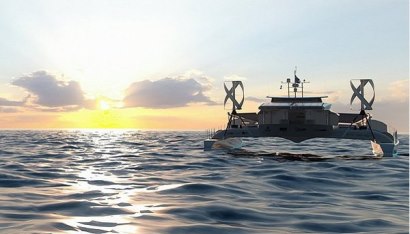Source: hazardexonthenet.net
Published: September 20, 2016
A 30-metre catamaran, powered by solar, wind and self-generated hydrogen, will be launched next February to sail around the world as a floating exhibition and clean energy laboratory. The Energy Observer is being built at a St Malo shipyard in western France and aims to circumnavigate the globe using only clean power, a feat similar to Solar Impulse 2’s recent solar-powered flight around the world.

Artist’s impression of the vessel at sea – Image: Energy Observer
In a former existence as a racing catamaran, the vessel won the 1994 Jules Verne Trophy for the fastest circumnavigation of the world. It is now being fitted with 130 square metres of solar panels, two vertical axis wind turbines, two reversible electric motors and electrolysis equipment to help produce and store hydrogen on board.
Energy Observer will also be equipped with a special 50 sq.m. kite wing to pull the boat along in following winds.
The boat will be the first in the world to produce hydrogen on board through desalination of sea water, according to ENSTA Bretagne. The hydrogen will be used not as a fuel but a way of storing energy – it can store 20 times more energy than conventional batteries. Equipment on the vessel will fill high-pressure hydrogen tanks which will power a fuel cell and generate electricity.
“We are going to be the first boat with an autonomous means of producing hydrogen,” Victorien Erussard told AFP. He, a merchant navy officer, and Jacques Delafosse, a documentary maker and professional scuba diver, are the co-founders of the project.
The plan is for the boat’s batteries, which will feed the electric motors, to be powered in good weather by solar and wind energy. If there is no sun or wind, stored hydrogen—generated by electrolysis powered by the solar panels and two wind turbines—will take over.
Erussard and Delafosse plan to sail Energy Observer around the world for six years, stopping at 101 ports in 50 countries.
The Energy Observer was designed in partnership with a team of naval architects and the CEA-Liten research institute in the French city of Grenoble, which is dedicated to renewable energy technologies.
At a total cost of €4.2m, the vessel will be fitted with sensors to act as moving laboratory for CEA-Liten, whose director Florence Lambert describes the project as a “great challenge”.
“Energy Observer is emblematic of what will be the energy networks of tomorrow, with solutions that could even be used within five years,” said Lambert.
“For example, the houses of tomorrow could incorporate a system of hydrogen storage, which is produced during the summer months and then used in the winter.”
The team will need to raise at least €4m a year to support the expedition around the globe, but are confident this will be possible.
Between 2010 and 2012, the Swiss-designed MS Tûranor PlanetSolar sailed around the world powered by solar energy alone. The 31-metre catamaran is covered by 537 sq.m. of solar panels rated at 93 kW, which in turn connect to two electric motors, one in each hull. There are 8.5 tons of lithium-ion batteries in the ship’s two hulls and it can reach speeds of up to 14 knots (26 km/h).
It is currently being used as a floating marine research laboratory by Geneva University.
